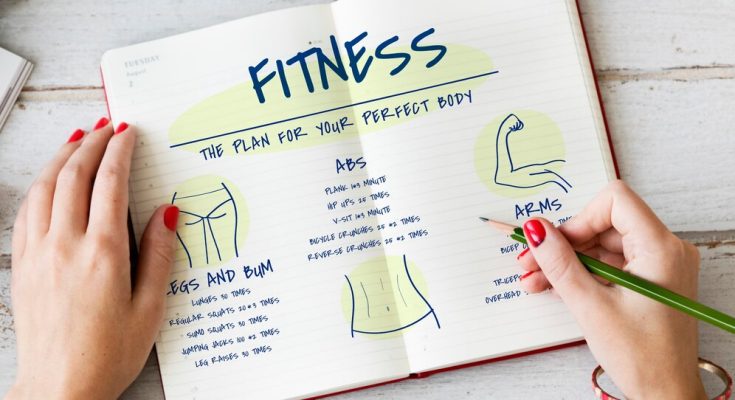A well-structured fitness plan is key to effective weight loss. Start by setting clear goals and choosing a mix of cardio and strength exercises. Create a weekly schedule that fits your routine, and track your progress regularly. Adjust as needed and complement your workouts with a balanced diet, proper hydration, and sufficient sleep for sustainable weight loss.

Why a Fitness Plan is Important for Weight Loss?
Consistent Calorie Burning: A structured fitness plan ensures you regularly engage in activities that help burn calories and promote fat loss.
Progress Tracking: It provides a clear roadmap, making it easier to track progress and stay motivated.
Healthy Habits Integration: Importantly, the plan combines exercise with healthy habits, ensuring you achieve weight loss goals in a sustainable and healthy way.
Steps to Create a Fitness Plan for Weight Loss:

Set Clear Goals:
Define Your Goals: Before you start, clearly define how much weight you want to lose and the time frame for achieving it.
Set Achievable Targets: For instance, aim to lose 1–2 pounds per week to stay motivated.
Understand the Process: Remember that weight loss is a gradual process, so patience and consistency are key.

Assess Your Current Fitness Level:
Evaluate Your Starting Point: Begin by assessing your current weight, strength, stamina, and overall health. This helps create a personalized fitness plan that suits your abilities and gradually challenges your body.
Choose the Right Type of Exercise:
- Cardiovascular Exercise: Engage in activities like walking, running, cycling, or swimming to burn calories and enhance heart health. Aim for 150–300 minutes of moderate-intensity cardio per week. If you’re new to exercise, start with brisk walking or light jogging.
- Strength Training: Incorporate exercises such as squats, lunges, push-ups, and weightlifting 2–3 times a week. Strength training builds muscle, which boosts your resting metabolic rate, allowing you to burn more calories throughout the day.
- High-Intensity Interval Training (HIIT): This method involves short bursts of intense activity followed by rest periods. HIIT is effective for burning fat quickly and typically lasts 20–30 minutes. Include exercises like sprinting, jumping jacks, and burpees.
Include Flexibility and Recovery: Add flexibility exercises like yoga or stretching to your routine to prevent injury and enhance mobility. Ensure your plan includes rest days for muscle recovery, which is crucial for long-term success.

Create a Weekly Schedule:
Design a workout routine that fits into your lifestyle. Plan for at least 5 days of activity per week, with a mix of cardio, strength, and flexibility exercises. For example:
Monday: Cardio (30–45 minutes of brisk walking or cycling)
Tuesday: Strength training (full-body workout)
Wednesday: HIIT (20 minutes)
Thursday: Rest or light yoga/stretching
Friday: Cardio (running or swimming)Saturday: Strength training (lower body focus)
Sunday: Active rest (walking or light stretching)
Monitor Progress: Tracking your progress is essential for maintaining motivation. Start by keeping a fitness journal or using an app to log your workouts, calories burned, and changes in your weight and body measurements.
Celebrate Small Victories: Along the way, acknowledge and celebrate small achievements, such as increased stamina or the ability to lift heavier weights. This helps keep you motivated and focused on your goals.
Adjust Your Plan as Needed: As your fitness level improves, your body will adapt to your current workout routine. Therefore, it’s important to increase the intensity of your workouts to prevent plateaus.
Increase Workout Intensity: To keep progressing, consider adding more weight, extending your cardio duration, or incorporating more challenging exercises into your routine.

Tips for Maximizing Your Fitness Plan for Weight Loss:
- Pair Exercise with a Balanced Diet:
Exercise alone won’t lead to significant weight loss. A healthy, balanced diet that creates a calorie deficit is essential. Focus on eating whole foods like vegetables, fruits, lean proteins, and whole grains. Avoid processed foods and excessive sugar. - Stay Hydrated:
Water plays a vital role in metabolism and helps regulate hunger. Drink plenty of water throughout the day, especially during workouts. - Get Enough Sleep:
Lack of sleep can hinder weight loss by affecting hunger hormones and energy levels. Aim for 7–9 hours of quality sleep per night to support recovery and overall health. - Consistency is Key:
A fitness plan only works if you stick to it. Make exercise a priority, and aim to build a routine that is sustainable long-term. If you miss a workout, don’t get discouraged—just get back on track the next day.

Common Mistakes to Avoid:
- Overtraining:
Too much exercise without adequate rest can lead to burnout and injuries. Ensure you have at least one full rest day each week. - Neglecting Strength Training:
Many people focus solely on cardio when trying to lose weight, but strength training is just as important for building muscle and boosting metabolism. - Unrealistic Expectations:
Weight loss takes time. Avoid crash diets and extreme workout regimens, which are unsustainable and can harm your health.
Summery:
Set Clear Goals: Begin by defining specific weight loss targets to guide your fitness journey. Clear goals will help keep you focused and motivated.
Choose the Right Exercises: Incorporate a balanced mix of cardio and strength training into your routine. Cardio helps burn calories, while strength training builds muscle and boosts metabolism.
Maintain Consistency: Stick to your fitness plan regularly and include proper rest to avoid overtraining. Consistency is crucial for achieving and maintaining weight loss.
Stay Patient and Adaptable: Remember, weight loss is a journey. Be patient, stay persistent, and adjust your plan as needed to continue progressing.
By following these steps, you’ll effectively shed pounds and improve your overall health.
References:
- Donnelly, J. E., et al. (2009). Appropriate physical activity intervention strategies for weight loss and prevention of weight regain for adults. Medicine and Science in Sports and Exercise, 41(2), 459–471.
- Swift, D. L., et al. (2018). The role of exercise and physical activity in weight loss and maintenance. Progress in Cardiovascular Diseases, 61(2), 206-213.
- Johns, D. J., et al. (2014). Diet or exercise interventions for sustained weight loss? A systematic review and meta-analysis of long-term randomized controlled trials. Obesity Reviews, 15(10), 773-785.




